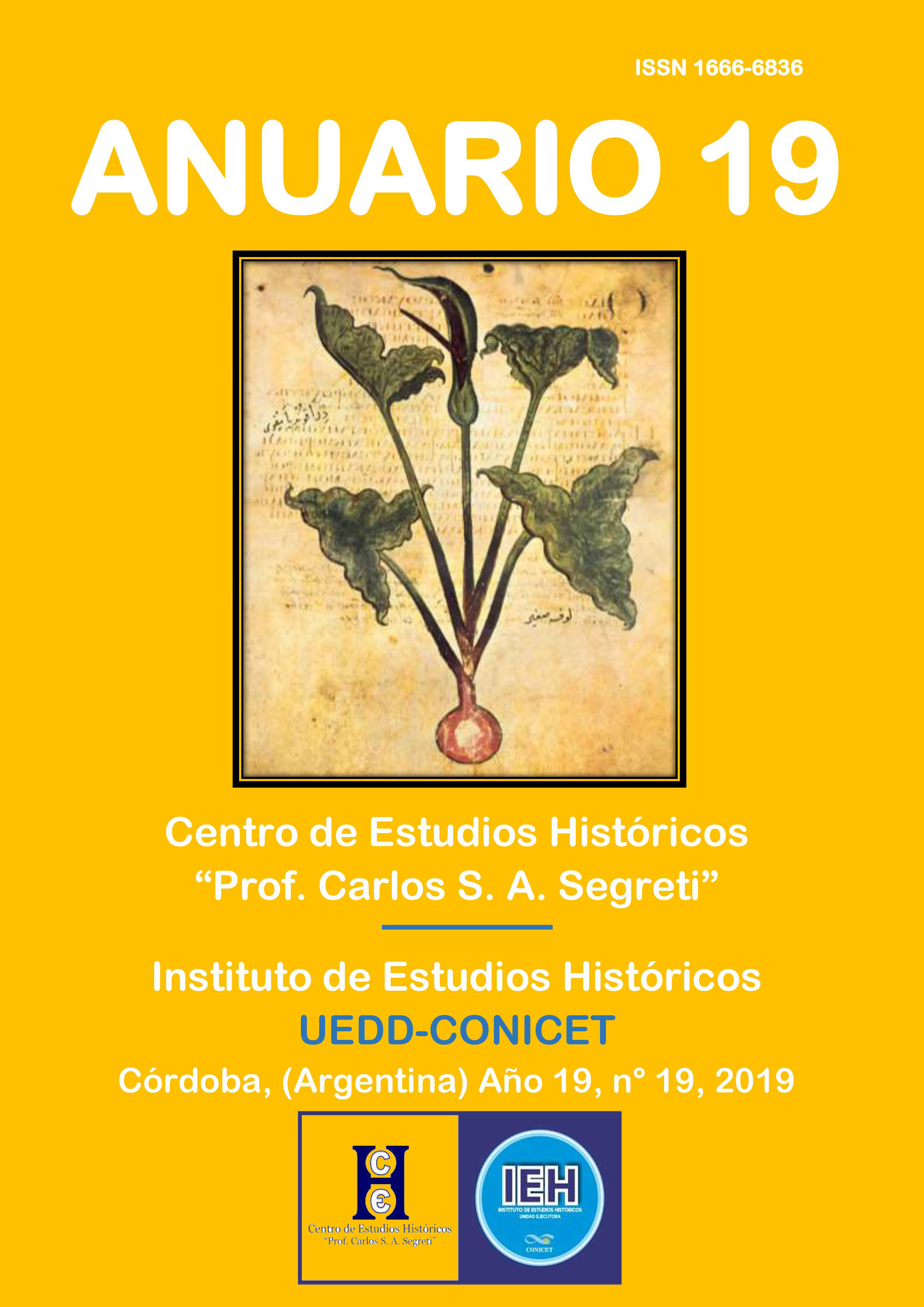Damasus and the pagans of Rome. Problematic around the conjuncture
DOI:
https://doi.org/10.52885/2683-9164.v.n19.25625Keywords:
Damaso; Christians; heathens; conjunctureAbstract
The purpose of this work is to propose a contribution to the studies referred to the problems arising from the encounter between pagans and Christians in Damaso's time, at crucial moments for the roman history. It is interesting to investigate, through detailed analysis of primary sources and significant historiographical studies, the motivations and strategies implemented by those who exercised political and religious power in the city. It aims to understand the mentality of both groups and their leaders, as well as their authentic significance in the process of transformation that took place in the Roman Empire during the fourth century.
Downloads
References
ANDRESEN Christian, “Siegreiche Kirche im Aufstieg des Christentems. Untersuchungen zu Eusebius von Caesarea und Dionysios von Alexandrien,” ANRW II, 23, 1, 1979.
BOCH Viviana, “Vetio Agorio Pretextato, visto por sus contemporáneos,” De Rebus Antiquis, Año 2, N°2, 2012.
CAMERON Alan, The Last Pagans of Rome, Oxford, 2011.
CHENAULT Robert R., “Beyond Pagans and Christians: Politics and Intra-Christian Conflict in the Controversy over the altar of Victory,” In: SALZMAN Michele, SÁGUY Marianne and LIZZI TESTA Rita, Pagans and Christians in the Late Antique Rome. Conflict, Competition, and Coexistence in the Fourth Century, Cambridge, Cambridge University Press, 2016.
COLLECTIO AVELLANA editado por O.Guenther: Epistolae Imperatorum Pontificum Aliorum Inde ab a. CCCLXVII utiliza datos de DLIII Avellana Quae Dicitur Collectio , CSEL vol. 35, 2 partes, Praga, Viena y Leipzig, 1895. https://www.fourthcentury.com/the-collectio-avellana/
DAGRON Gilbert, Empereur et Prêtre. Étude sur le ‘césaropapisme’ byzantin, Paris, 1997.
DESCHNER Karlheinz, Historia criminal del cristianismo, Barcelona, Martínez Roca, 1991.
DI BERARDINO Angelo, Diccionario Patrístico y de la Antigüedad Cristiana, T. II (J-Z), Salamanca, Sígueme, 1998.
GARCÍA MORENO Luis A., El Bajo Imperio Romano, Madrid, Síntesis, 1998
HUBEÑÁK Florencio, “El hispano Teodosio y la cristianización del Imperio,” Hispania Sacra 51, 1999.
LATINAE SVPPLEMENTA. Vol. I. Damasi epigrammata. Accedvnt Pseudodamasiana Aliaqve ad Damasiana, Inlvstranda idonea recensvit MAXIMILIANUS IHM, Lipsiae in aedibus B.G Tevbneri, MDCCCLXXXXV.
LÓPEZ BARJA DE QUIROGA Pedro y LOMAS SALMONTE Francisco Javier, Historia de Roma, Madrid, AKAL, 2004.
LLORCA Bernardino, GARCÍA VILLOSLADA Ricardo, MONTALBÁN Francisco (1976) Historia de la Iglesia Católica, T. I, Edad Antigua. Madrid: BAC. 1976.
MAIER Franz George, “Las transformaciones del mundo mediterráneo. Siglos III/VIII”, Historia Universal Siglo Veintiuno. Madrid, Siglo XXI, 1972.
MACCARRONE Michele, “Il Primato del vescovo di Roma nel primo millennio.” Atti del Symmposium storico-teologico, 1989. Cittá del Vaticano, 1991.
MARCELINO AMIANO, Historia del Imperio Romano desde el año 350 al 378. Vertida al castellano por F. Norberto Castilla, Madrid, Librería de la Viuda de Hernando, 1896.
MCINTYRE Thomas J., The First Pontiff: Pope Damasus I and the Expansion of the Roman Primacy, Georgia Southern University, 2015.
MORENO RESANO Esteban, “El elogio del emperador Constantino en la literatura cristiana de su época.” En: Anuario de Historia de la Iglesia, vol. 22, 2013.
NORTON Margaret Ann, “Prosopography of Pope Damasus,” Folia 4,1950, 5, 1951, pp.3055; 6, 1952, Repr. in: Leaders of Iberean Christianity 50-650 A.D.; edited by MARIQUE Joseph, , Boston, Saint Paul, 1962.
PIGANIOL André, L´Empire chrétie, Paris, Presses Universitaires de France, 1947, p. 245. Los datos de sus cargos se encuentran en CIL VI, 1779.
PILARA Gianluca y GHILARDI Massimiliano, La città di Roma nel pontificato di Damaso (366-384). Vicende storiche e aspetti archeologici, Roma. ARACNE, 2010.
RÉMONDON Roger, La crisis del Imperio roman, Barcelona, Labor, 1973
RUFINO Storia della Chiesa, cura di Lorenzo Dattrino, Roma, Citta Nova, 1986.
SAN JERÖNIMO Epistolario. Edición bilingüe, Tomo I. Trad., Introd. y notas por Juan Bautista Valero, Madrid: BAC., MCMXCIII.
SÍMACO Quinto Aurelio, Cartas. Introd., trad. y notas de José Antonio Valdés Gallego, Madrid, Gredos, 2000.
SÍMACO Quinto Aurelio, Informes. Discursos. Introd., trad. y notas Valdés Gallego, J. A Madrid, Gredos, 2003.
THÜMMEL Hans G., “Eusebios’ Brief an Kaiserin Konstantia,” En Klio, 66 (1984).
VERA Doménico, Commento Storico alle Relationes di Quinto Aurelio Simmaco. Introduzione, commento, testo, traduzione, appendice sul libro X, 1-2, indici. Pisa, Giardini Editori, 1981.
WARBURG Inés, Poética y tradiciones discursivas en los Elogia funerarios en el corpus epigramático damasiano, Vol. 2, Buenos Aires, Universidad de Buenos Aires, Facultad de Filosofía y Letras, Instituto de Filosofía Clásica, Sección de Filología Medieval, 2010, uba_ffyl_t_2010_861358_v2 (3).pdf.
WACE Henry, A Dictionary of Christian Biography and Literature to the End of the Sixth Century A.D., with an Account of the Principal Sects and Heresies, Publisher: Grand Rapids, MI: Christian Classics Ethereal Library, Rights: Public Domain, URL: http://www.ccel.org/ccel/wace/biodict.htm, Date Created: 2000/07/15.
Downloads
Published
How to Cite
Issue
Section
License
Aquellos autores/as que tengan publicaciones con esta revista, aceptan los términos siguientes:
- Los autores/as conservarán sus derechos de autor y garantizarán a la revista el derecho de primera publicación de su obra, el cuál estará simultáneamente sujeto a una Licencia de reconocimiento de Creative Commons. Se puede compartir, copiar, distribuir, ejecutar y comunicar públicamente la obra, siempre que: a) se cite la autoría y la fuente original de su publicación (revista, editorial y URL de la obra); b) no se use para fines comerciales; c) no se altere, transforme o genere una obra derivada a partir de esta obra.
- Los autores/as podrán adoptar otros acuerdos de licencia no exclusiva de distribución de la versión de la obra publicada (p. ej.: depositarla en un archivo telemático institucional o publicarla en un volumen monográfico) siempre que se indique la publicación inicial en esta revista.
- Se permite y recomienda a los autores/as difundir su obra a través de Internet (p. ej.: en archivos telemáticos institucionales o en su página web) después del proceso de publicación, lo cual puede producir intercambios interesantes y aumentar las citas de la obra publicada. (Véase El efecto del acceso abierto).


